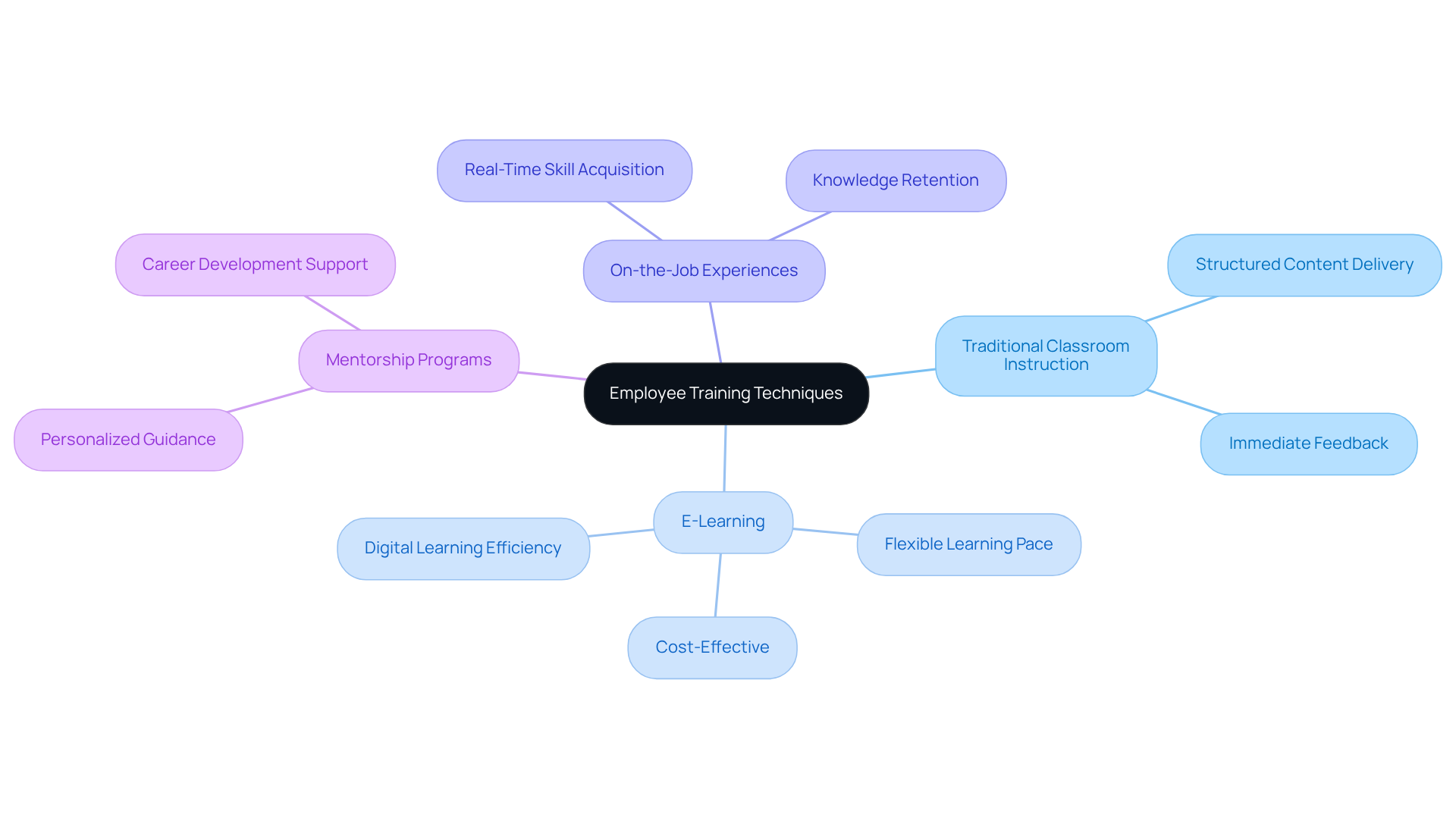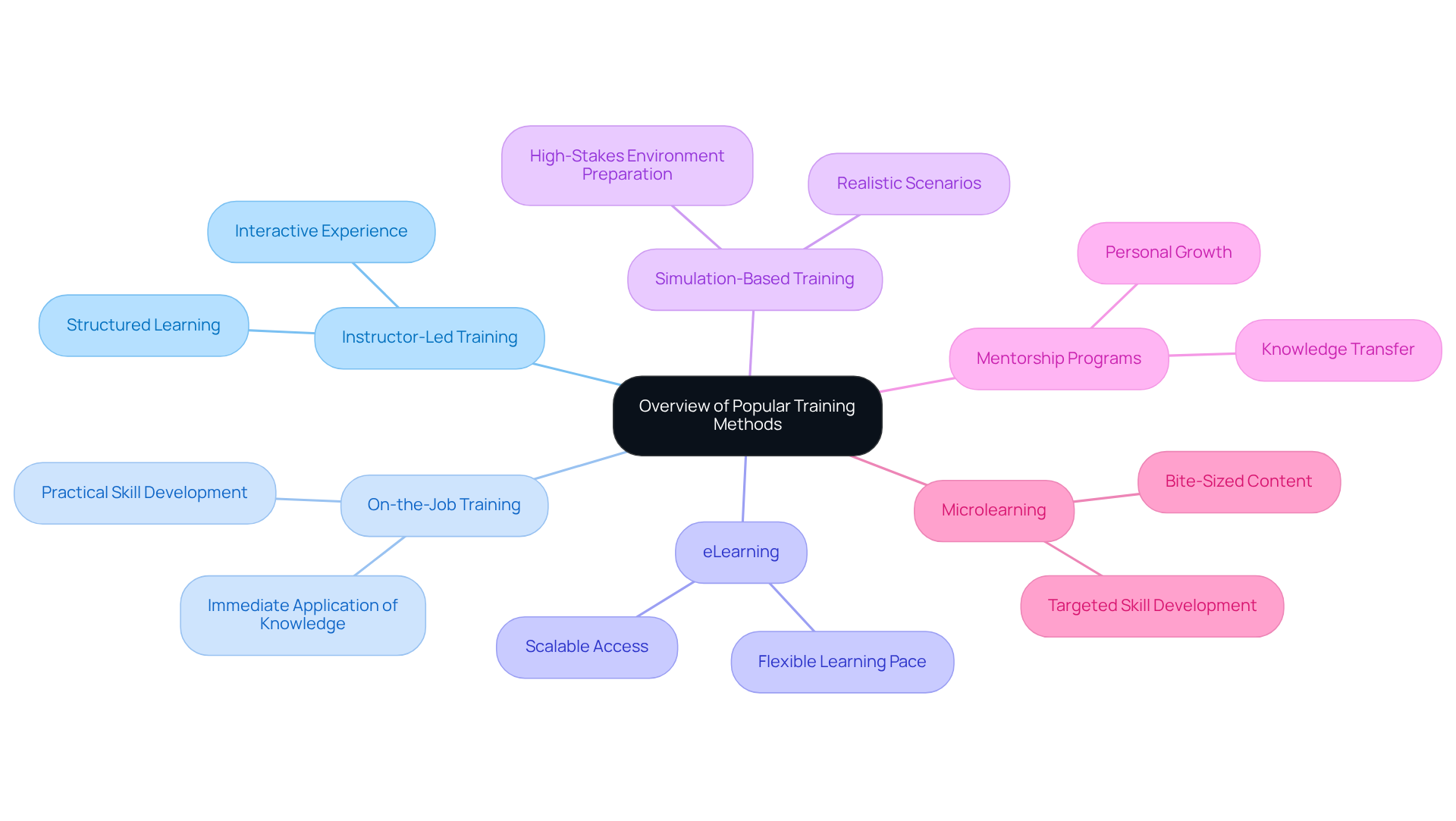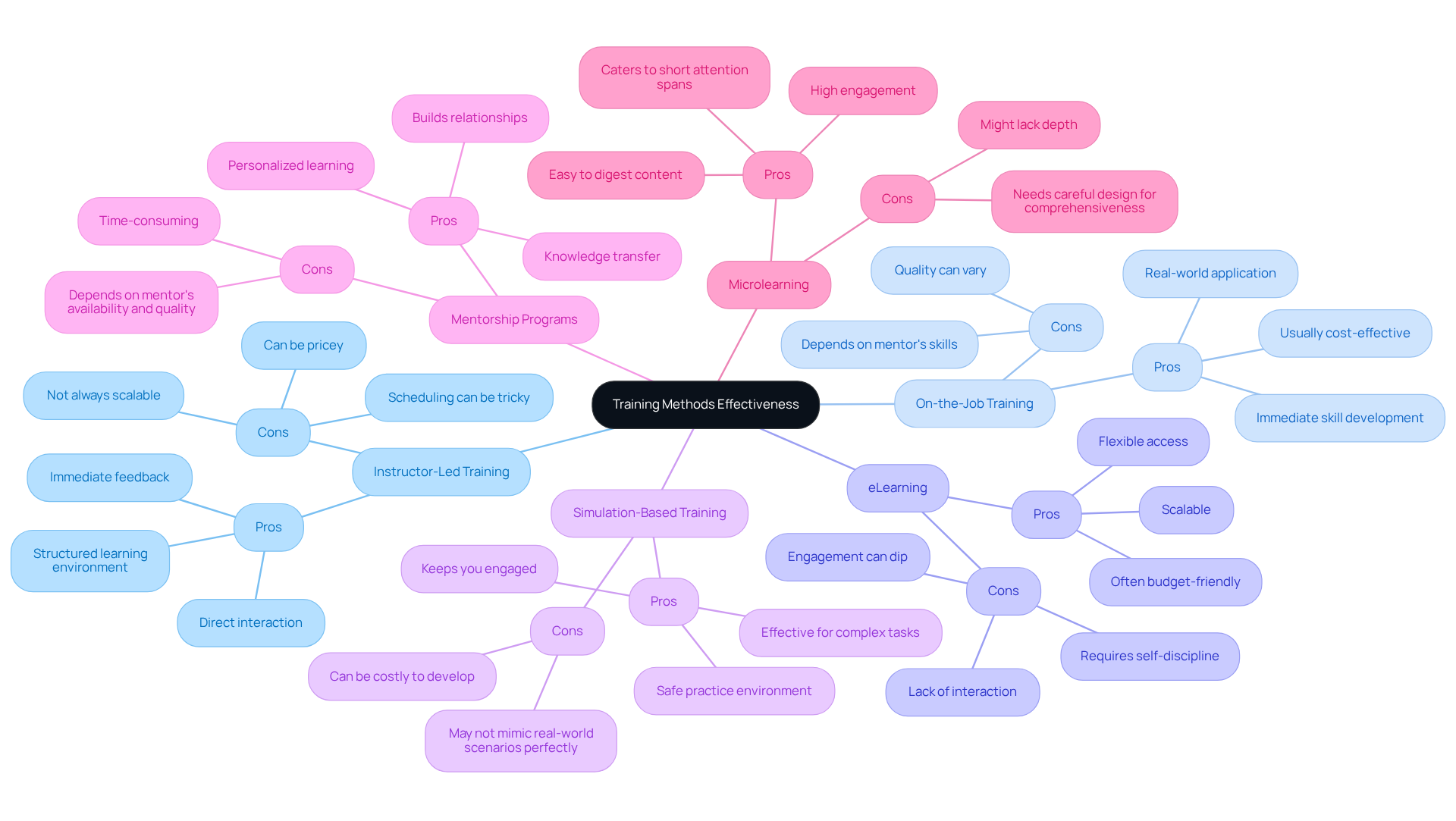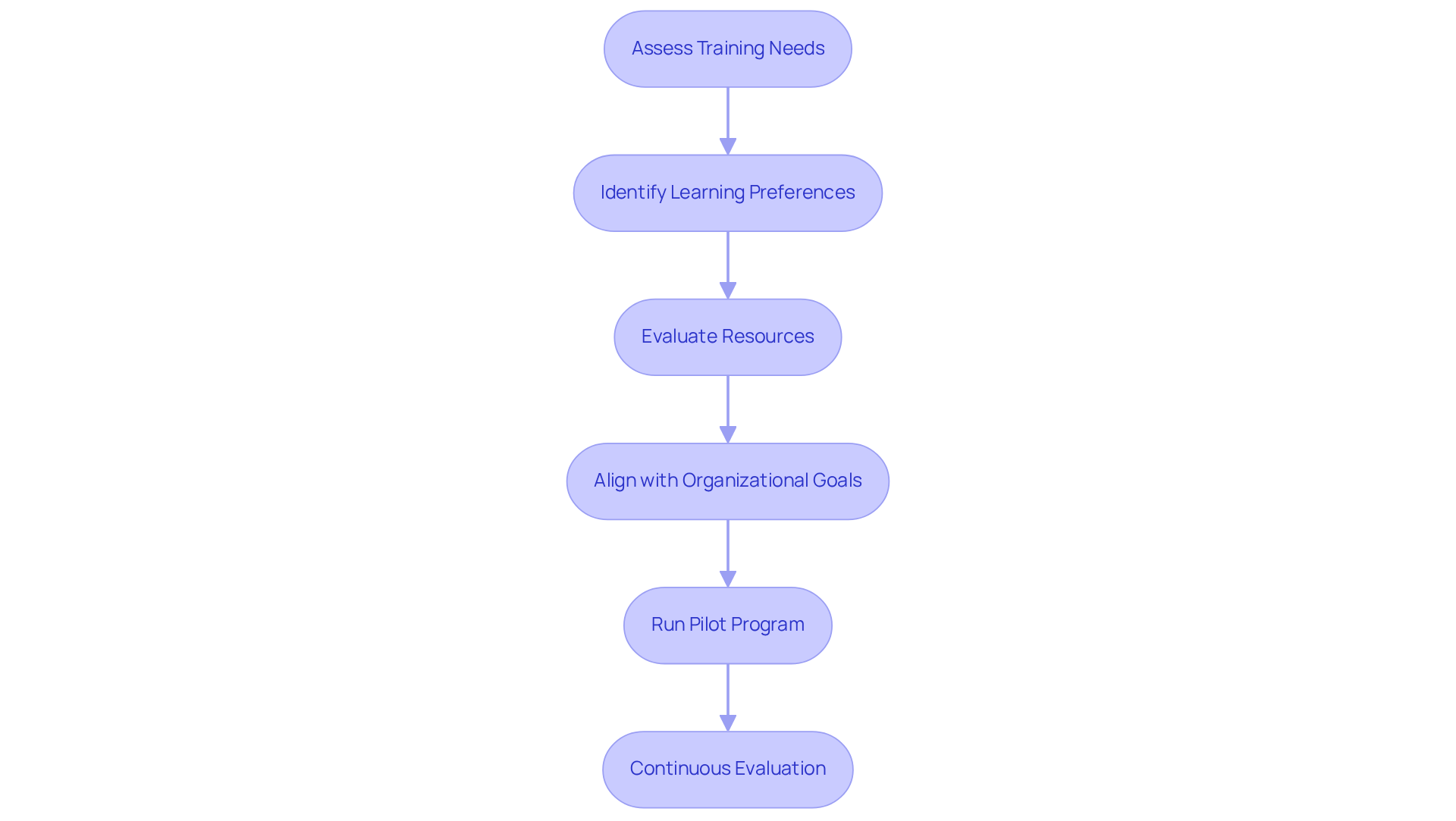
Overview
You might be wondering how to effectively develop your team. Well, this article takes a closer look at various training techniques that can really make a difference! We’re talking about methods like:
- Instructor-Led Training (ILT)
- On-the-Job Training (OJT)
- eLearning
- Simulation-Based Training
- Mentorship Programs
- Microlearning
Each of these methods comes with its own set of unique benefits and challenges.
Now, let’s dive into what this means for you. Choosing the right training technique isn’t just about picking a method; it’s about understanding your team’s skills gaps, their learning preferences, and how these align with your organization’s goals. After all, the aim is to enhance employee capabilities and drive overall success. So, think about what might work best for your team and how you can implement these strategies effectively!
Key Highlights:
- Employee training techniques enhance workers' skills, understanding, and effectiveness.
- Common methods include Instructor-Led Training (ILT), On-the-Job Training (OJT), eLearning, Simulation-Based Training, Mentorship Programmes, and Microlearning.
- ILT offers structured learning and direct interaction but can be costly and less scalable.
- OJT allows real-world skill application but depends on the mentor's effectiveness.
- eLearning provides flexibility and accessibility but may lack engagement and interaction.
- Simulation-Based Training is ideal for safe practise in complex tasks but can be expensive to develop.
- Mentorship Programmes foster personal growth and knowledge transfer but can be time-consuming.
- Microlearning caters to short attention spans with high engagement but may lack depth.
- Investing in employee development correlates with increased profitability and employee retention.
- Choosing the right training method requires assessing skills gaps, learning preferences, resources, and alignment with organisational goals.
- Continuous evaluation of training programmes is essential for maintaining their effectiveness.
Introduction
You might be wondering how understanding the diverse landscape of employee training techniques can really make a difference in fostering a culture of growth and efficiency within organizations. As businesses aim to boost their workforce capabilities, choosing the right training method can lead to some significant improvements in employee performance and satisfaction. But with so many options out there—from traditional classroom settings to cutting-edge e-learning platforms—how do organizations figure out which approach will give them the best results?
Exploring the pros and cons of various training techniques not only uncovers the opportunities for development but also highlights the challenges that come with each method. This prompts us to think a bit deeper about what truly drives effective team development. So, let’s dive into this together and see what we can discover!
Understanding Employee Training Techniques
You might be wondering how staff development strategies can really make a difference in the workplace. Well, they utilize various training techniques aimed at boosting workers' abilities, understanding, and overall effectiveness. From traditional classroom instruction to modern e-learning platforms, on-the-job experiences, and mentorship programs, each method serves its unique purpose and can be tailored to fit the specific needs of your organization. Grasping these techniques is crucial for fostering a culture of ongoing learning and development, which ultimately leads to better performance and happier employees.
For example, traditional instructor-led education (ILT) does a great job of delivering structured content, while e-learning offers the flexibility to learn at your own pace—pretty handy, right? On-the-job instruction lets workers pick up skills in real-time, which really helps with knowledge retention and practical application. And get this: studies show that organizations with solid development programs see a whopping 218% increase in income per staff member and enjoy a 24% higher profit margin. Talk about financial benefits!
Now, let’s dive into why investing in employee development is so important. Organizations that prioritize this report 11% greater profitability and are twice as likely to keep their employees around. This really underscores the need to align development strategies with business goals. HR experts emphasize that customized and engaging educational experiences are key; in fact, 93% of employees look for opportunities that are easy to complete and relevant to their roles. Plus, 70% of staff feel more engaged when learning is gamified. By thoroughly assessing and applying various training techniques, you can significantly enhance your workforce's capabilities and drive overall success.

Overview of Popular Training Methods
You might be wondering about the best ways to help employees grow and develop their skills. Well, various training techniques are widely recognized for their effectiveness in employee development. Let’s take a look at some of them:
- Instructor-Led Training (ILT). This is your traditional classroom-style training where an instructor leads the way. It’s great for structured learning and allows for some good old-fashioned interaction between the trainer and the participants.
- On-the-Job Training (OJT). This is where employees learn by actually doing their job, all while being supervised by someone more experienced. It’s super effective for developing practical skills and applying knowledge right away.
- eLearning. Think online courses that give employees the flexibility to learn at their own pace. This method is becoming increasingly popular because it’s accessible and scalable—perfect for today’s busy workforce.
- Simulation-Based Training. Here, employees get to engage in realistic scenarios that mimic their job tasks. This approach is especially useful in high-stakes environments where practical experience really counts.
- Mentorship Programs. This is where less experienced employees are paired with seasoned professionals. It’s all about fostering knowledge transfer and personal growth, plus it emphasizes building those important relationships.
- Microlearning. This involves brief, focused segments of education that target specific skills. It’s a fantastic way to cater to the modern learner’s preference for bite-sized content.
Each of these approaches, which includes various training techniques, comes with its own unique benefits, and choosing the right one really depends on the specific goals you have in mind and what works best for your employees.

Evaluating Effectiveness: Pros and Cons of Each Method
Evaluating the effectiveness of training methods? Let's break down their pros and cons together:
-
Instructor-Led Training (ILT):
- Pros: You get direct interaction, immediate feedback, and a structured learning environment.
- Cons: But it can be pricey, scheduling can be tricky, and it’s not always scalable.
-
On-the-Job Training (OJT):
- Pros: This one’s great for real-world application, immediate skill development, and it’s usually cost-effective.
- Cons: Just keep in mind, the quality can vary, and it really depends on your mentor’s skills.
-
eLearning:
- Pros: Talk about flexible! You can access it from anywhere, it’s scalable, and often more budget-friendly.
- Cons: However, you might miss out on interaction, engagement can dip, and it requires some self-discipline.
-
Simulation-Based Training:
- Pros: This is perfect for practicing in a safe environment, keeping you engaged, and it works wonders for complex tasks.
- Cons: Just a heads-up, it can be costly to develop and might not perfectly mimic real-world scenarios.
-
Mentorship Programs:
- Pros: You get personalized learning, build relationships, and benefit from knowledge transfer.
- Cons: But it can be time-consuming and really depends on the mentor’s availability and quality.
-
Microlearning:
- Pros: This one’s all about high engagement, catering to short attention spans, and making content easy to digest.
- Cons: Just remember, it might lack depth and needs careful design to cover everything comprehensively.
By weighing these elements, you can get a clearer picture of which development approaches and various training techniques are in alignment with your goals and your team's needs. So, which method do you think might work best for you?

Choosing the Right Training Method for Your Team
Choosing the right training method for your team? It's all about considering a few key factors!
First off, you might be wondering how to assess training needs. Start by pinpointing the specific skills and knowledge gaps in your team. Surveys or interviews can be super helpful here—just ask your staff what they feel they need to learn. This way, you ensure that the development is not only relevant but also targeted.
Next, let’s talk about learning preferences. Remember, not everyone learns the same way! Some folks thrive on practical experience, while others might prefer the flexibility of self-paced eLearning. Understanding these preferences is crucial in guiding your approach to selection.
Now, don’t forget to evaluate your resources. Take a good look at your budget, time constraints, and available technology. Some various training techniques might require a hefty investment, while others can be pulled off with limited resources. Flexibility is key here!
And what about aligning with organizational goals? Make sure the training method you choose supports the bigger picture. For example, if enhancing customer service is a priority, simulation-based exercises could be just the ticket to achieving that goal.
Before you dive in completely, consider running a pilot program. This little test run can help you gauge its effectiveness and gather feedback from participants. It’s a great way to refine your approach before rolling it out on a larger scale.
Finally, continuous evaluation is essential. After implementing your program, keep assessing its effectiveness through feedback, performance metrics, and employee engagement levels. This ongoing check-in will help you make any necessary adjustments, ensuring the program stays impactful.
By following these steps, you can make informed decisions that truly enhance your training programs using various training techniques, contributing to both team development and overall organizational success. So, are you ready to take the plunge into effective training?

Conclusion
You might be wondering just how important employee training techniques really are. Well, they're absolutely crucial for boosting workforce capabilities and driving your organization's success! By exploring a mix of methods—from the classic instructor-led training to cutting-edge e-learning and mentorship programs—you can create a culture of continuous learning. Picking the right training technique not only tackles specific skill gaps but also aligns with your broader business goals, leading to happier, more productive employees.
Let's take a closer look at some popular training methods.
- Instructor-led training is great for interaction and structure.
- On-the-job training gives practical experience.
- E-learning is all about flexibility.
- Simulation-based training immerses employees in real-world scenarios.
- Mentorship programs cater to different learning styles.
- Microlearning makes development relevant and engaging.
By weighing these methods against your organization's needs and resources, you can make smart choices that really amp up the effectiveness of your training initiatives.
In today's fast-paced workplace, investing in effective training techniques is more important than ever. So, it's time to prioritize tailored development strategies that not only sharpen employee skills but also fuel overall business success. By taking a proactive approach to employee training, you can cultivate a motivated workforce that's ready to tackle whatever challenges come next, driving both individual and organizational growth. Now, doesn’t that sound like a win-win?
Frequently Asked Questions
What are employee training techniques?
Employee training techniques are strategies used to enhance workers' abilities, understanding, and overall effectiveness. These techniques include traditional classroom instruction, modern e-learning platforms, on-the-job experiences, and mentorship programs.
Why is it important to understand different training techniques?
Understanding different training techniques is crucial for fostering a culture of ongoing learning and development, which leads to better performance and happier employees.
What are the benefits of traditional instructor-led education (ILT)?
Traditional instructor-led education (ILT) effectively delivers structured content, providing a clear framework for learning.
How does e-learning benefit employees?
E-learning offers flexibility, allowing employees to learn at their own pace, which can accommodate different learning styles and schedules.
What is the advantage of on-the-job instruction?
On-the-job instruction allows workers to acquire skills in real-time, enhancing knowledge retention and practical application.
What financial benefits do organizations see from solid development programs?
Organizations with strong development programs experience a 218% increase in income per staff member and a 24% higher profit margin.
How does investing in employee development impact profitability and retention?
Organizations that prioritize employee development report 11% greater profitability and are twice as likely to retain their employees.
What do HR experts say about educational experiences for employees?
HR experts emphasize that customized and engaging educational experiences are essential, with 93% of employees seeking opportunities that are easy to complete and relevant to their roles.
How does gamification affect employee engagement in learning?
Approximately 70% of staff feel more engaged when learning experiences are gamified, making the training process more enjoyable and effective.
👍
What others are liking
5 Steps to outline your ideal documentation structure
5 MINS READ
Where to start the your journey of mapping out your ideal documentation structure, aligning it with the very heartbeat of your organization?
Defining a winning level of detail in your process
3 MINS READ
What is too much detail, and what is too little? This article described in that winning level detail about what detail is enough.





